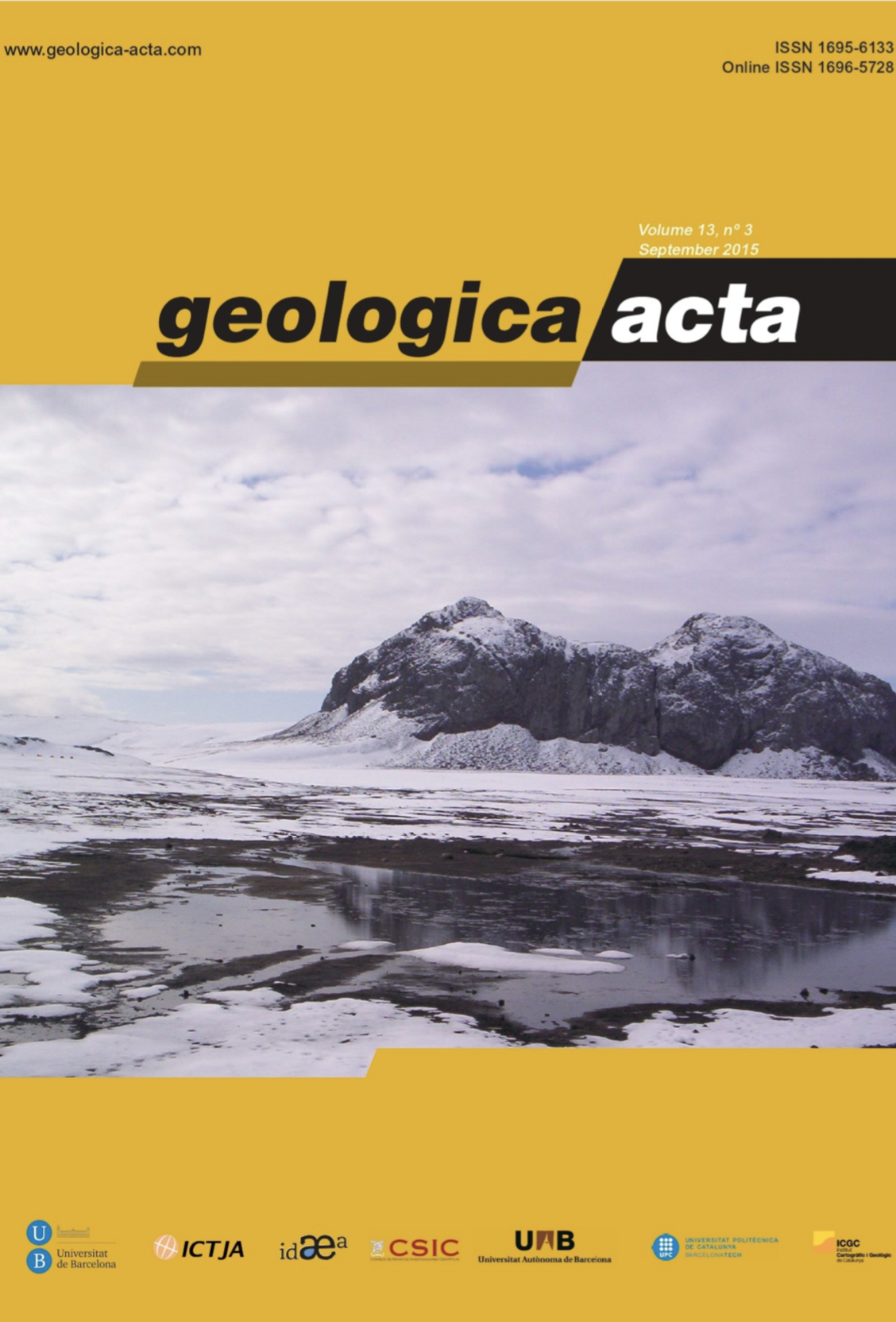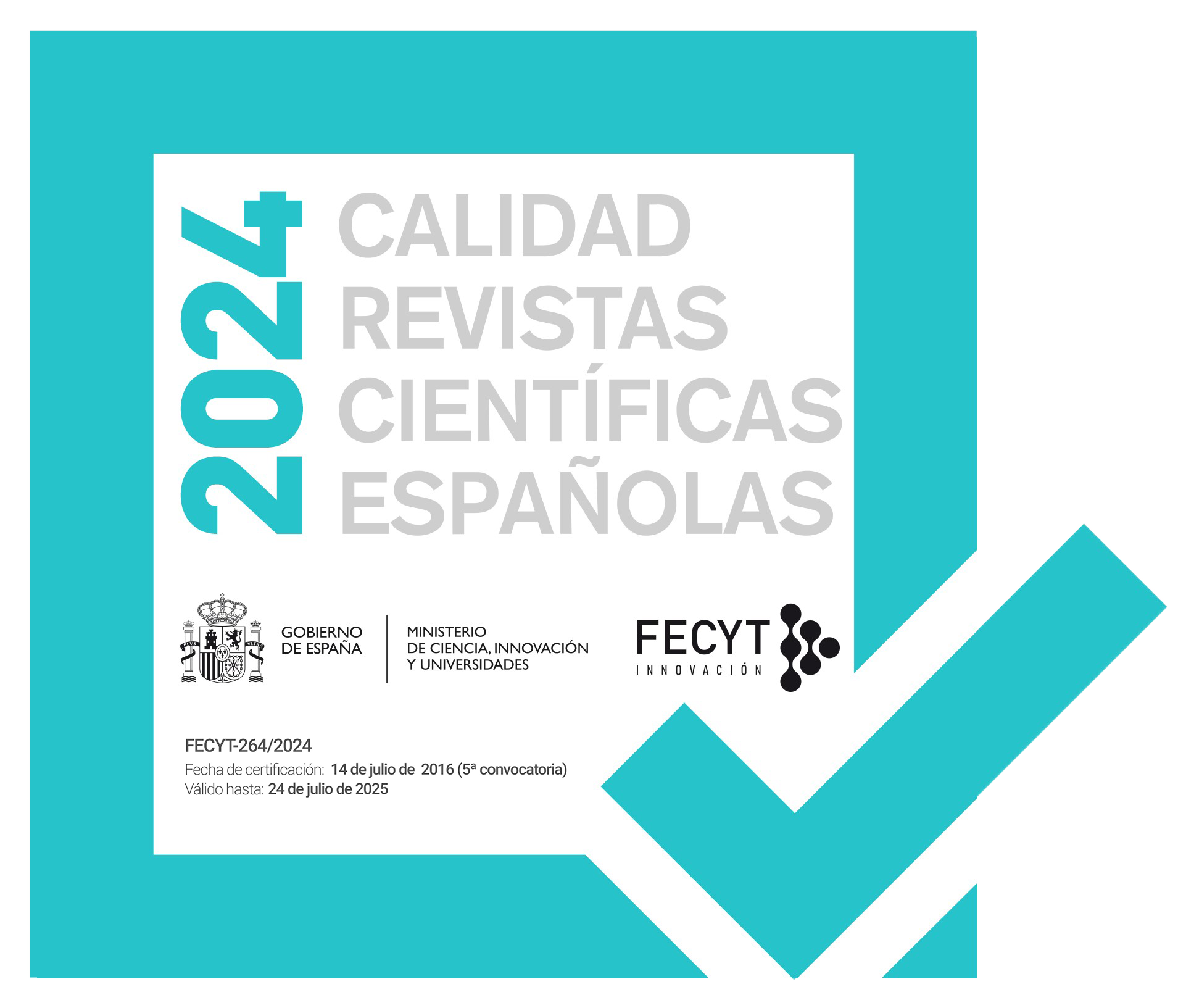Structure of a complex carbonate aquifer by magnetic, gravity and TDEM prospecting in the Jaén area, Southern Spain
DOI:
https://doi.org/10.1344/GeologicaActa2015.13.3.2Keywords:
Carbonate aquifer, Potential field research, Electromagnetic prospecting, Betic Cordillera, Groundwater resources, Hydrogeological continuityAbstract
Knowledge of aquifer geometry is essential for efficient and sustainable groundwater management, particularly in carbonate aquifers due to uncertainties inherent to karstic systems. The geological structure and hydrogeological continuity of Los Chotos-Sazadilla-Los Nacimientos and La Serreta-Gante-Cabeza Montosa carbonate aquifers (Jaén; SE Spain) have been established through structural measurements, geophysical prospecting –magnetic, gravity and time-domain electromagnetics (TDEM)– and the study of piezometric levels. Yet the scarce hydrogeological data, the complexity of the tectonic structure and the presence of Plio-Quaternary rocks covering the highly permeable carbonate rocks make it difficult to establish a robust conceptual hydrogeological model of the aquifer. This study focuses on an area where hydrogeological disconnection between the two aquifers was traditionally assumed, given the diapiric emplacement of low permeable rocks between them. The new geophysical data demonstrate connection between aquifers that implies greater groundwater reserves than previously supposed. This field example supports the suitability of the combined use of electromagnetic methods with gravity and magnetic research that have been poorly combined up to recent times for hydrogeological studies.
References
Ayarza, P., Alvarez-Lobato, F., Teixell, A., Arboleya, M.L., Tesón, E., Julivert, M., Charroud, M., 2005. Crustal structure under the central High Atlas Mountains (Morocco) from geological and gravity data. Tectonophysics, 400, 67-84.
Bakalowicz, M., 2005. Karst groundwater: a challenge for a new resources. Hydrogeoly Journal, 13, 148-160.
Basso, B., Kendall, A., Hyndman, D.W., 2013. The future of agriculture over the Ogallala Aquifer: Solutions to grow crops more efficiently with limited water. Earth’s Future, 1, 39-41.
Bedrosian, P.A., Burgess, M.K., Nishikawa, T., 2013. Faulting and groundwater in a desert environment: constraining hydrogeology using time-domain electromagnetic data. Near Surface Geophysics, 11(5), 545-555.
Chalikakis, K., Plagnes, V., Guerin, R., Valois, R., Bosch, F.P., 2011. Contribution of geophysical methods to karsts-system exploration: an overview. Hydrogeology Journal, 19, 1169-1180.
Chambers, J., Kuras, O., Meldrum, P., Ogilvy, R., Hollands, J., 2006. Electrical resistivity tomography applied to geologic, hydrogeologic, and engineering investigations at a former waste-disposal site. Geophysics, 71(6), B231-B239.
Cheng, Y., Mao, J., Rusk, B., Yang, Z., 2012. Geology and genesis of Kafang Cu-Sn deposit, Gejiu district, SW China. Ore Geology Reviews, 48, 180-196.
Dafflon, B., Irving, J., Holliger, K., 2009. Use of high-resolution geophysical data to characterize heterogeneous aquifers: Influence of data integration method on hydrological predictions. Water Resources Research, 45, W09407.
Duque, C., Calvache, M.L., Pedrera, A., Martín-Rosales, W.M., López-Chicano, M., 2008. Combined time domain electromagnetic soundings and gravimetry to determine marine intrusion in a detrital coastal aquifer (Southern Spain). Journal of Hydrology, 349, 536-547.
Finn, C. A., Morgan, L.A., 2002. High-resolution aeromagnetic mapping of volcanic terrain, Yellowstone National Park. Journal of Volcanology and Geothermal Research, 115, 207-231.
Foster, S., Tuinhof, A., Garduño, H., Kempe, K., Koundouri, P., Nanni, M., 2006. Groundwater Resource Development in Minor Aquifers. Management strategy for village and small town water supply. GW Mate Briefing Notes, 13.
García-Hernández, M., López-Garrido, A.C., Rivas, P., Sanz de Galdeano, C., Vera, J.A., 1980. Mesozoic palaeogeographic evolution of the External Zones of the Betic Cordillera. Geologie en Mijnbouw, 59(2), 155-168.
Gibson, P.J, Lyle, P., George, D.M., 1996. Environmental applications of magnetometry profiling. Environmental Geology, 27, 178-183.
Hammer, S., 1982. Critique of Terrain Corrections for Gravity Stations. Geophysics, 47, 839-840.
IAGA Working Group V-MOD, 2010. International Geomagnetic Reference Field: the eleventh generation. Geophysical Journal International, 183(3), 1216-1230.
IGME-DPJ, 2011. Atlas hidrogeológico de la provincia de Jaén. Eds. Instituto Geológico y Minero de España, 142-151.
ITGE, 1990. Informe final de la perforación y aforo realizados para abastecimiento en el término municipal de Cabra del Santo Cristo (Jaén). http://www.igme.es/internet/sistemas_infor/ConsultaSID/presentacion.asp?Id=4081
Izett, G.A., 1975. Late Cenozoic Sedimentation and Deformation in Northern Colorado and Adjoining Areas. Geological Society of America Memoir, 144, 179-210.
Karner, G.D., Studinger, M., Bell, R.E., 2005. Gravity anomalies of sedimentary basins and their mechanical implications; Application to the Ross Sea basins, West Antarctica. Earth and Planetary Science Letters, 235, 577-596.
Kirsch, R., 2009. Groundwater geophysics a tool for hydrogeology. Berlin, Springer, 556pp. Website: http://public.eblib.com/EBLPublic/PublicView.do?ptiID=603393
La Femina, P.C., Connor, C.B., Stamatakas, J.A., Farrell, D.A., 2002. Imaging an active normal fault in alluvium by high-resolution magnetic and electromagnetic surveys. Environmental and Engineering Geoscience, 8, 193-207.
Mancera, E., 2013. Evaluación de la recarga en un acuífero carbonático sometido a explotación intensiva. El acuífero de Bedmar-Jodar (Jaén). Master Thesis. Universidad de Málaga, Spain, 78pp.
Martos-Rosillo, S., Marín-Lechado, C., Pedrera, A., Vadillo, I., Motyka, J., Molina, J.L., Ortiz, P., Martín-Ramírez, J.M., 2014. Methodology to evaluate the renewal period of carbonate aquifers: a key tool for their management in arid and semiarid regions, with the example of Becerrero aquifer, Spain. Hydrogeology Journal, 22, 679-689.
Mishra, D.C., Vijay Kumar, V., 2005. Evidence for Proterozoic collision from airborne magnetic and gravity studies in Southern Granulite Terrain, India, and signatures of recent tectonic activity in the Palghat Gap. Gondwana Research, 8(1), 43-54.
Nielsen, L., Jørgensen, N.O., Gelting, P., 2007. Mapping of the freshwater lens in a coastal aquifer on the Keta Barrier (Ghana) by transient electromagnetic soundings. Journal of Applied Geophysics, 62(1), 1-15.
Pedley, R.C., Busby, J.P., Dabeck, Z.K., 1993. Gravmag User Manual- Interactive 2.5D gravity and magnetic modelling. British
Geological Survey. Technical Report, WK/93/26/R, 75pp.
Pedrera, A., Marín-Lechado, C., Galindo-Zaldívar, J., GarcíaLobón, J.L., 2013. Control of preexisting faults and nearsurface diapirs on geometry and kinematics of fold-and-thrust belts (Internal Prebetic, Eastern Betic Cordillera). Journal of Geodynamics, 77, 135-148.
Pérez-López, A., 1991. El Trías de facies germánica del sector central de la Cordillera Bética. PhD Thesis. Universidad de Granada, Spain, 400pp.
Pérez-López, A., 1996. Sequence model of coastal-plain depositional systems of the Upper Triassic (Betic Cordillera, southern Spain). Sedimentary Geology, 101, 99-117.
Peters, L.J., 1949. The direct approach to magnetic interpretation and its practical application. Geophysics, 14, 290-320.
Pulido-Bosch, A., Motyka, J., Pulido-Leboeuf, P., Borczak, S., 2004. Matrix hydrodynamic properties of carbonate rocks from the Betic Cordillera (Spain). Hydrological Processes, 18, 2893-2906.
Ruiz Reig, P., Álvaro López, M., Hernández Samaniego, A., del Olmo Zamora, P., 1988a. Mapa Geológico Nacional, Escala
:50.000. Hoja 948 (Torres). Instituto Geoligico y Minero de España (IGME).
Ruiz Reig, P., Díaz de Neira Sánchez, J.A., Enrile Albir, A., López Olmedo, F., 1988b. Mapa Geológico Nacional, Escala 1:50.000. Hoja 970 (Huelma). Instituto Geoligico y Minero de España (IGME).
Ruiz-Constán, A., Galindo-Zaldívar, J., Pedrera, A., Sanz de Galdeano, C., 2009. Gravity anomalies and orthogonal box fold development on heterogeneous basement in the Neogene Ronda Depression (Western Betic Cordillera). Journal of. Geodynamics, 47(4), 210-217.
Ruiz-Constán, A., Pedrera, A., Galindo-Zaldívar, J., Pous, J., Arzate, J., Roldán-García, F.J., Marín-Lechado, C., Anahnah, F., 2012. Constraints on the frontal crustal structure of a continental collision from an integrated geophysical research: The central-western Betic Cordillera (SW Spain). Geochemistry Geophysics Geosystems, 13(8), 19pp.
Smyth, H.L., 1896. Magnetic observations in geological mapping. American Institute of Mining and Metallurgical Engineers.
Transactions, 26, 640-709.
Soupios, P.M., Kouli, M., Vallianatos, F., Vafidis, A., Stavroulakis, G., 2007. Estimation of aquifer hydraulic parameters from
surficial geophysical methods: A case study of Keritis Basin in Chania (Crete-Greece). Journal of Hydrogeology, 338, 122-131.
Teixell, A., Arboleya, M.L, Julivert, M., 2003. Tectonic shortening and topography in the central High Atlas (Morocco). Tectonics, 22(5), 1051-1065. DOI:10.1029/2002TC001460.
Telford, W.M., Geldart, L.P., Sheriff, R.E., 1990. Applied Geophysics. Cambridge University press, 792pp.
Tronicke, J., Holliger, K., 2005. Quantitative integration of hydrogeophysical data: conditional geostatistical simulation for characterizing heterogeneous alluvial aquifers. Geophysics, 70(3), H1-H10.
Vera, J.A., 2004. Cordillera Bética y Baleares. In: Vera, J.A. (ed.). Geología de España. Sociedad Geológica de España, Instituto Geológico y Minero de España, 345-464. Wantland, D., 1944. Magnetic interpretation. Geophysics, 9, 47-58.
WHYMAP, 2008. Groundwater Resources of the World. Map 1:25.000.000. UNESCO, IAH, BGR, CGMW, IAEA. (World-Wide Hydrogeological Mapping and Assessment Programme). Website: http://www.whymap.org/whymap/EN/Downloads/Global_maps/gwrm_2008_pdf
Zietz, I., Kirby, J.R. Jr., 1972. Aeromagnetic map of Colorado: U.S. Geological Survey. Geophysical Series Map GP-880 scale 1:1.000.000.
Downloads
Published
Issue
Section
License

This work is licensed under a Creative Commons Attribution-ShareAlike 4.0 International License.
Copyright
Geologica Acta is the property of the UB, GEO3BCN, IDAEA and UAB. Geologica Acta must be cited for any partial or full reproduction. Papers are distributed under the Attribution-Share Alike Creative Commons License. This license allows anyone to reproduce and disseminate the content of the journal and even make derivative works crediting authorship and provenance and distributing possible derivative works under the same or an equivalent license.
Author Rights
Authors retain the copyright on their papers and are authorized to post them on their own web pages or institutional repositories. The copyright was retained by the journal from the year 2003 until 2009. In all cases, the complete citation and a link to the Digital Object Identifier (DOI) of the article must be included.
The authors can use excerpts or reproduce illustrations of their papers in other works without prior permission from Geologica Acta provided the source of the paper including the complete citation is fully acknowledged.




